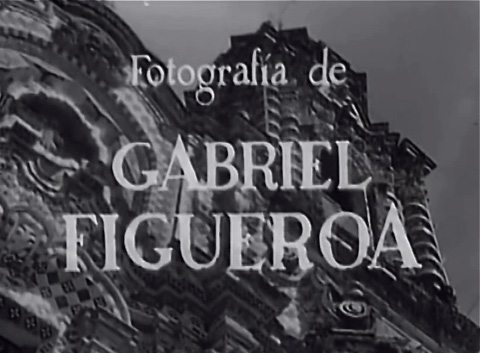
 In a career that spanned more than five decades and over two hundred films, cinematographer Gabriel Figueroa became one of the true poets of cinema. He became interested in painting from a very early age and as a teenager, his passion for images led him to explore photography. Hand picked by Howard Hawks to work in Viva Villa! he would end up being trained in Hollywood by Citizen Kane cinematographer Gregg Toland. Upon his return to Mexico, where he spent most of his career, Figueroa became known for his exquisite use of black and white. He shot some of the most iconic films in Mexican cinema and challenged viewers’ expectations of the textures and hues that could be achieved with black and white. He collaborated with director Emilio Fernández on over two dozen films which would earn them accolades in Cannes, Berlin and Venice.
In a career that spanned more than five decades and over two hundred films, cinematographer Gabriel Figueroa became one of the true poets of cinema. He became interested in painting from a very early age and as a teenager, his passion for images led him to explore photography. Hand picked by Howard Hawks to work in Viva Villa! he would end up being trained in Hollywood by Citizen Kane cinematographer Gregg Toland. Upon his return to Mexico, where he spent most of his career, Figueroa became known for his exquisite use of black and white. He shot some of the most iconic films in Mexican cinema and challenged viewers’ expectations of the textures and hues that could be achieved with black and white. He collaborated with director Emilio Fernández on over two dozen films which would earn them accolades in Cannes, Berlin and Venice.
His work has influenced every major cinematographer of the modern era, some of which try to emulate his extraordinary compositions and use of light. His work is so revered that Diego Rivera went on to call him, “Mexico’s fourth great muralist” (next to himself, Orozco and Siqueiros) and his work helped enhance the idea of Mexican pride that lives on through their passion and pride in their culture. Figueroa’s oeuvre could deem him an auteur of the films he worked in, perhaps even more so than the directors he worked under. From June 5 to the 18th, his work will be featured at a retrospective in Film Forum. The retrospective includes some of his major works in both Hollywood and Mexico, and is being presented in conjunction with an exhibit at El Museo del Barrio (which runs through June 27).
Even though each and every single film in the retrospective is worthy of a viewing (The Night of the Iguana and Enamorada are ravishing!) we picked the five films you simply can’t miss:
Emilio Fernández became the first Mexican director to have a film screened at the Cannes Film Festival with this story of a young Indian woman (Dolores del Río) who is constantly punished for her beauty. If nothing else this is a lovesong to del Río’s magnificent face, and Figueroa shoots her with a combination of tenderness and lust that are truly compelling to watch. The film won the Grand Prix at Cannes (what is now called the Palm d’Or) and became del Río’s most iconic picture.
The breathtaking Marga López stars as Mercedes, a dancer at the title ballroom who is forced to steal money from her pimp (Rodolfo Acosta) when he refuses to give her what she is owed. Also directed by Fernández it allowed Figueroa to go out to the streets of beautiful Mexico City and capture some of its electrifying qualities, he makes great use of the labyrinthine alleys and streets to represent the emotional turmoil of the heroine. Also worthy of note is how the film could very well be silent, but thanks to Figueroa’s compositions we could still practically “hear” the beats the characters are dancing to. A noir entry as essential as Double Indemnity and La Bete Humaine, it’s the kind of film that acknowledges the worst human traits and sees them through a hazy, smokey filter allowing for some hope.
Some of Figueroa’s most iconic images came from this adaptation of John Steinbeck’s novel in which a desperate father (played by Fernández, who also directed the film) recurs to theft in order to save his son’s life. The haunting hum of the ocean gives path to a collection of phantasmagoria that makes the heart stop. Despite the film’s innately tragic nature, there are several sequences that burst with life and joy, such as a moment midway through in which we see a festival with a band and fireworks, all exceptionally captured by Figueroa’s lens.
One of Figueroa’s last films had him collaborate with director John Huston in an adaptation of a semi-autobiographical novel by Malcolm Lowry which has Albert Finney play an alcoholic former diplomat living in the town of Quauhnahuac. Figueroa’s peculiar use of color captures the vibrancy of Mexican culture while contrasting with the dourness of Finney’s character. Cultural clash as seen through light and color.
Roberto Gavaldón’s lyrical fable stars Ignacio López Tarso as an indigenous man who unexpectedly becomes the object of a battle between the Devil, God and Death. Based on a novel by B. Traven, which itself was inspired by a Brothers Grimm tale allows Figueroa to make great use of light and images to represent the supernatural. While not technically a horror film by any means, Macario features some of the creepiest images in all of cinema.
Gabriel Figueroa runs at Film Forum from June 5-18. The retrospective is presented in conjunction with “Under the Mexican Sky: Gabriel Figueroa — Art and Film,” an exhibition at El Museo Del Barrio and in association with Fundación Televisa, El Museo del Barrio, Cinema Tropical, and The Mexican Cultural Institute of New York, with the support of Filmoteca de la Unam, the Mexican Agency for International Development Cooperation, and the Consulate General of Mexico in New York.